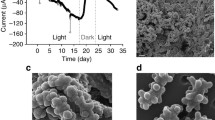Abstract
Ectothiorhodospira halochloris grows photoheterotrophically with a variety of sulfur sources. During sulfide oxidation to elemental sulfur considerable amounts of polysulfides may be accumulated transiently. When grown on elemental sulfur no sulfate was produced by oxidation, but sulfide and polysulfide were formed by reduction. Only one soluble cytochrome c-551 was isolated and purified. It was a small acidic hemeprotein with a molecular weight of 6,300, an isoelectric point of 3.1 and a redox potential of-11 mV at pH 7.0. It showed three absorption maxima in the reduced state (α=551 nm; β=523 nm; γ=417 nm). The addition of various c-type cytochromes to a suspension of spheroplasts stimulated the velocity of sulfide oxidation. This stimulation was best with the small acidic cytochromes from E. halochloris or Ectothiorhodospira abdelmalekii. Sulfide oxidation was stopped by several uncoupling agents, ionophores and electron transport inhibitors. Antimycin A, rotenone and cyanide had no effect on sulfide oxidation.
Similar content being viewed by others
References
Dickerson RE, Timkovich S (1975) Cytochromes c. In: Boyer PD (ed) The enzymes, vol 11. Academic Press. New York, pp 397–547
Dodgson KS (1961) Determination of inorganic sulphate in studies on the enzymic and non-enzymic hydrolysis of carbohydrate and other sulphate esters. Biochem J 78:312–319
Fehér F, Laue W (1956) Beiträge zur Chemie des Schwefels. XXIX. Über die Darstellung von Rohsulfanen. Z Anorg Allg Chem 288:103–112
Fischer U, Trüper HG (1977) Cytochrome c-550 of Thiocapsa roseopersicina, properties and reduction by sulfide. FEMS Microbial Lett 1:87–90
Fukumori Y, Yamanaka T (1979) Flavocytochrome c of Chromatium vinosum. Some enzymatic properties and subunit structure. J Biochem 85:1405–1414
Imhoff JF, Trüper HG (1977) Ectothiorhodospira halochloris sp. nov., a new extremely halophilic phototrophic bacterium containing bacteriochlorophyll b. Arch Microbiol 114:115–121
Imhoff JF, Trüper HG (1981) Ectothiorhodospira abdelmalekii sp. nov., a new halophilic and alkaliphilic phototrophic bacterium. Zbl Bakt Hyg I Abt Orig C 2:228–234
Jones CW (1976) Biological energy conservation. Chapman and Hall. London
Kusai A, Yamanaka T (1973 a) A Cytochrome c (553, Chlorobium thiosulfatophilum) is a sulfide-cytochrome c reductase. FEBS Lett 34:235–237
Kusai A, Yamanaka T (1973 b) The oxidation mechanism of thiosulfate and sulfide in Chlorobium thiosulfatophilum: roles of cytochrome c-551 and cytochrome c-553. Biochim Biophys Acta 325:304–314
Novozamsky I, Van Eck R (1977) Total sulfur determination in plant material. Z Anal Chem 286:367–368
Petushkova Y, Ivanovsky RN (1976) Respiration of Thiocapsa roseopersicina. Microbiologiya 45:9–14
Raymond JC, Sistrom WR (1967) The isolation and preliminary characterization of a halophilic photosynthetic bacterium. Arch Microbiol 59:255–268
Raymond JC, Sistrom WR (1969) Ectothiorhodospira halophila: A new species of the genus Ectothiorhodospira. Arch Microbiol 69:121–126
Roy AB, Trudinger PA (1970) The biochemistry of inorganic compounds of sulfur. Cambridge University Press, Cambridge
Steinmetz MA, Fischer U (1982) Cytochromes, rubredoxin, and sulfur metabolism of the non-thiosulfate-utilizing green sulfur bacterium Pelodictyon luteolum. Arch Microbiol 132:204–210
Steinmetz MA, Trüper HG, Fischer U (1983) Cytochromes c-555 and iron-sulfur-proteins of the non-thiosulfate-utilizing green sulfur bacterium Chlorobium vibrioforme. Arch Microbiol 135:186–190
Stetter KO, Gaag G (1983) Reduction of molecular suphur by methanogenic bacteria. Nature 305:309–311
Then J, Trüper HG (1983) Sulfide oxidation in Ectothiorhodospira abdelmalekii. Evidence for the catalytic role of cytochrome c-551. Arch Microbiol 135:254–258
Trüper HG (1964) Sulphur metabolism in Thiorhodacea. II. Stoichiometric relationship of CO2 fixation to oxidation of hydrogen sulphide and intracellular sulphur in Chromatium okenii. Antonie van Leeuvenhoek. J Microbiol Serol 30:385–394
Trüper HG (1968) Ectothiorhodospira mobilis Pelsh, a photosynthetic sulfur bacterium depositing sulfur outside the cells. J Bact 95:1910–1920
Trüper HG, Fischer U (1982) Anaerobic oxidation of sulphur compounds as electron donors for bacterial photosynthesis. Phil Trans R Soc Lond B 298:529–542
Van Gemerden H (1967) On the bacterial sulfur cycle of inland waters. Doctoral thesis, University of Leiden, The Netherlands
Van Gemerden H (1968) On the ATP generation by Chromatium in darkness. Arch Microbiol 64:118–124
Author information
Authors and Affiliations
Additional information
Dedicated to Prof. Dr. H. G. Schlegel on the occasion of his 60th birthday
Rights and permissions
About this article
Cite this article
Then, J., Trüper, H.G. Utilization of sulfide and elemental sulfur by Ectothiorhodospira halochloris . Arch. Microbiol. 139, 295–298 (1984). https://doi.org/10.1007/BF00408369
Received:
Accepted:
Issue Date:
DOI: https://doi.org/10.1007/BF00408369




